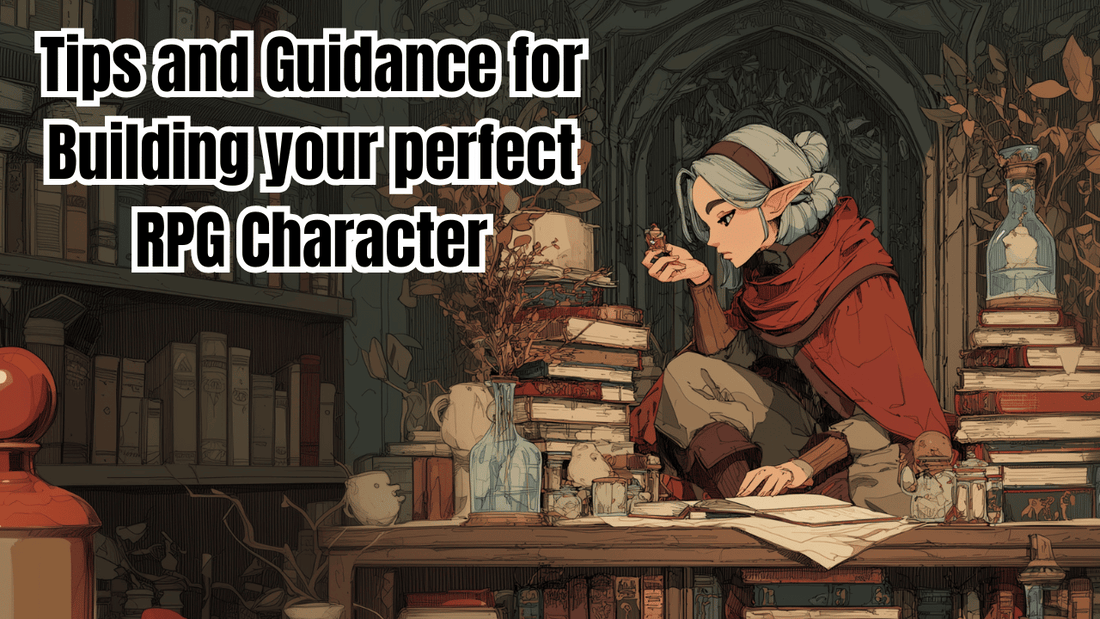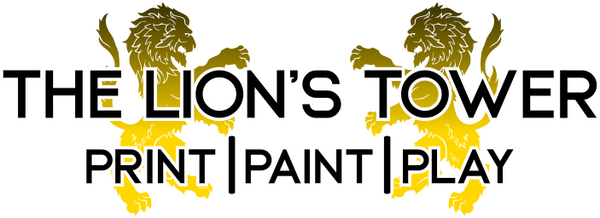
Tips and Guidance for Building your perfect RPG Character
Dan KellyShare
After rolling more characters than a casino craps table, I’ve come to one inevitable truth: inspiration can come from anywhere. A book you read in your teens. A moody anime you binged last winter. That one cinematic trailer that hit you right in the feels. Even the scribbled doodle on your old maths homework from 1997. But today, we’re zeroing in on a special source of inspiration: the miniature.
I’ve been playing Dungeons & Dragons and other tabletop RPGs for decades, and somewhere along the way, the hobby of painting and collecting miniatures wormed its way into my heart. More than once, I’ve started building a character not with a blank sheet of paper and a Player’s Handbook, but with a miniature that caught my eye. And let me tell you: reverse-engineering a character from a miniature is chef’s kiss for immersion and creativity.
Let me show you how to turn a beautiful or evocative mini into a character you’ll fall in love with.
Step 1: Find the Miniature That Sparks Your Imagination
The first step is simple: scroll through collections like the Heroes Collection, Female Miniatures, or Villains Collection on The Lion’s Tower until you find that one. You’ll know it when you see it. Maybe it’s a badass female knight, or perhaps it’s a Drow weapons master. Maybe it’s a halfling that looks like he just robbed half the city blind. If you already own a physical resin version, even better — pick it up, turn it over in your hand, and start imagining the story.

For example, take Alenor the Elven Sorceress. She's striking — tall, elegant, wrapped in flowing robes, and accompanied by a mischievous-looking familiar. Her body language tells us she’s confident, maybe even defiant. Her staff and familiar suggest a magical heritage. But there’s something just a little... playful? Mysterious? There’s depth waiting to be explored.

Step 2: Let the Visual Details Lead the Story
Miniatures are jam-packed with storytelling clues, whether you realise it or not. Start examining:
1. Clothing and Gear
-
Is the character wearing tattered rags or noble robes? That’s background right there. A dusty traveller could be a wandering bard or disgraced prince.
-
Alenor wears ornate robes — clearly crafted with care and power. This isn’t a hedge-witch. She’s trained. Possibly a former court mage?
2. Weapons and Magic Items
-
What does their weapon say about them? A giant greataxe screams rage and brutality. A curved dagger might whisper assassinations and secrets.
-
Alenor’s staff is beautifully detailed. Magical, surely. Does it channel elemental power? Is it a family heirloom? Was it gifted by her mentor before a tragic betrayal?
3. Pose and Expression
-
Body language says a lot. Are they relaxed or tense? Laughing or sneering?
-
Alenor’s raised hand and confident stance suggests command of her magic — and her surroundings. A leader? Or a rebel?
4. Companions and Props
-
Does the model include an animal, like Griblett the imp? That suggests a Warlock or Sorcerer with a pact. Maybe a summoner or beast master.
Make notes. Let every detail feed your creativity.
Step 3: Choose a Class That Matches the Miniature
Now that you’ve soaked in the visual details, pick a class that matches. But don’t be afraid to go unconventional. Just because they’re wearing heavy armour doesn’t have to mean fighter or paladin.
Here’s how I often break it down:
-
Warrior-types: Sword, axe, shield, or heavy armour? Could be a Fighter, Barbarian, or Paladin.
-
Magical gear: Runes, staves, spellbooks? Think Wizard, Sorcerer, Warlock.
-
Light armour and agility: Rogue, Ranger, or Bard.
-
Religious symbols: Cleric or Paladin.
With Alenor, a Sorcerer makes perfect sense. She looks born to magic, and the imp familiar suggests a possible Fiendish or Shadow origin. But you could also make her a Warlock, with Griblett as her infernal patron’s envoy.
Tip: Sometimes the best characters come from leaning into contrasts. A rough-looking half-orc mini might actually be a soft-spoken bard. A sinister-looking rogue might be a reluctant hero.
Step 4: Build the Backstory from the Ground Up
This is where the fun really begins. You’ve got the visual. You’ve got the class. Now start asking the questions:
-
Where did they get their gear? Was it handed down, stolen, or earned?
-
Who trained them? Were they raised in an academy, by wolves, or in secret by a rival noble house?
-
What do they want? Power? Redemption? Revenge? A good sandwich?
-
What’s the deal with the weird scar / glowing eyes / missing hand?
Let’s go back to Alenor.
"Alenor was once apprentice to a high elven archmage in the crystalline spires of Farvale. But her hunger for knowledge — and her tendency to ask uncomfortable questions — earned her exile. With Griblett, a mischievous imp who may or may not be her former rival transformed by a hex gone wrong, she now wanders the mortal realms. Seeking truth. Seeking power. Seeking, possibly, a decent bottle of wine."
From this you can build out your personality traits, flaws, ideals, and bonds. Every D&D sheet comes alive when it connects to your mini.
Step 5: Don’t Forget the Table Realities
A few practical tips from the seasoned trenches:
✦ Size and Reach:
Does your mini carry a huge weapon? Think about using reach weapons, polearms, or feats like Great Weapon Master.
✦ Equipment:
Your mini has a crossbow, two knives and a backpack? Take them all. Let the loadout match.
✦ Custom Features:
Some DMs will let you reflavour things. That flaming sword doesn’t have to deal fire damage mechanically — but it can look cool and be woven into your character’s theme.
Step 6: Pull From Pre-Existing Lore
The Lion’s Tower often provides ready-made backstories for their characters. This is gold.
Maybe you don’t have time to write a novel for your next sorcerer. Cool. Use the story from the product page and tweak it slightly. Maybe change a few names, switch out the setting, and boom — you've got a fully realised character ready for the table.
If your group is big on improvisation or you’re starting a one-shot, this shortcut lets you drop into character fast without sacrificing depth.
Bonus: What If You Have Multiple Minis You Love?
Why pick just one? Build a party!
Some of my most memorable characters came from choosing two or three miniatures that I liked and then imagining their relationships.
-
A noble-looking knight and a scrappy rogue? Former lovers turned enemies.
-
A stoic dwarf Bloodhunter and a drunken ogre Bandit? Lifelong friends from the same orphanage.
-
Alenor the sorceress and a brooding elf ranger? Estranged siblings now reunited by prophecy.
By using miniatures as a visual springboard, your game world becomes vibrant, your characters real, and your backstories compelling.
Final Thoughts
Choosing a character from a miniature flips the process — and that’s exactly why it’s so rewarding. It pulls you out of your mechanical brain and into your creative one. Instead of trying to make a character who’s “good at the game,” you make one who’s good for the story.
You start with a mystery — who is this figure? — and your game becomes the journey to answer that question.
So next time you’re staring at your miniature shelf or browsing the gorgeous sculpts at The Lion’s Tower, ask yourself: What’s this character’s story? Then write it. Play it. Live it.
And if you find yourself stuck, remember the golden rule:
"If you can’t decide on a character… just pick the miniature with the best boots."
Happy adventuring!
